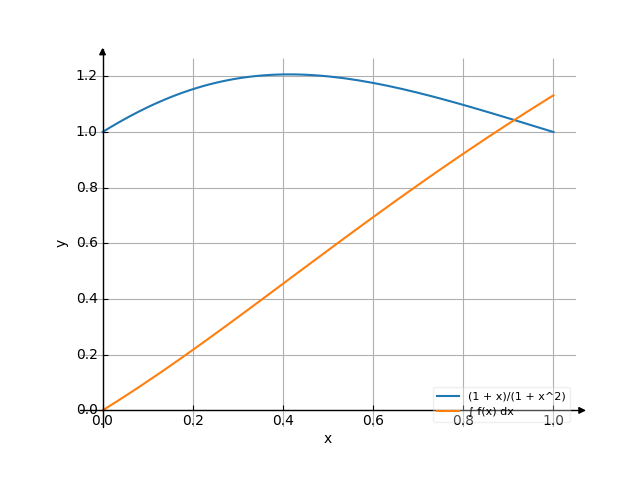Integral of (1+x)/(1+x^2) dx
The solution
You have entered
[src]
1 / | | 1 + x | ------ dx | 2 | 1 + x | / 0
$$\int\limits_{0}^{1} \frac{x + 1}{x^{2} + 1}\, dx$$
Integral((1 + x)/(1 + x^2), (x, 0, 1))
Detail solution
We have the integral:
/ | | 1 + x | 1*------ dx | 2 | 1 + x | /
Rewrite the integrand
/ 1*2*x + 0 \
|--------------|
| 2 |
1 + x \1*x + 0*x + 1/ 1
------ = ---------------- + -----------------
2 2 / 2 \
1 + x 1*\(-x + 0) + 1/or
/ | | 1 + x | 1*------ dx | 2 = | 1 + x | /
/
|
| 1*2*x + 0
| -------------- dx
| 2
| 1*x + 0*x + 1 /
| |
/ | 1
-------------------- + | ------------- dx
2 | 2
| (-x + 0) + 1
|
/ In the integral
/
|
| 1*2*x + 0
| -------------- dx
| 2
| 1*x + 0*x + 1
|
/
--------------------
2 do replacement
2 u = x
then
the integral =
/
|
| 1
| ----- du
| 1 + u
|
/ log(1 + u)
----------- = ----------
2 2 do backward replacement
/
|
| 1*2*x + 0
| -------------- dx
| 2
| 1*x + 0*x + 1
| / 2\
/ log\1 + x /
-------------------- = -----------
2 2 In the integral
/ | | 1 | ------------- dx | 2 | (-x + 0) + 1 | /
do replacement
v = -x
then
the integral =
/ | | 1 | ------ dv = atan(v) | 2 | 1 + v | /
do backward replacement
/ | | 1 | ------------- dx = atan(x) | 2 | (-x + 0) + 1 | /
Solution is:
/ 2\
log\1 + x /
C + ----------- + atan(x)
2
The answer (Indefinite)
[src]
/ | / 2\ | 1 + x log\1 + x / | ------ dx = C + ----------- + atan(x) | 2 2 | 1 + x | /
$$\int \frac{x + 1}{x^{2} + 1}\, dx = C + \frac{\log{\left(x^{2} + 1 \right)}}{2} + \operatorname{atan}{\left(x \right)}$$
The graph
The answer
[src]
log(2) pi ------ + -- 2 4
$$\frac{\log{\left(2 \right)}}{2} + \frac{\pi}{4}$$
=
=
log(2) pi ------ + -- 2 4
$$\frac{\log{\left(2 \right)}}{2} + \frac{\pi}{4}$$
The graph

Use the examples entering the upper and lower limits of integration.

![Find the integral of y = f(x) = (1+x)/(1+x²) dx ((1 plus x) divide by (1 plus x squared)) - with detailed solution [THERE'S THE ANSWER!] (1+x)/(1+x^2)](/media/krcore-image-pods/176/hash/indefinite/b/cc/eacf18c12023ff762664e8f91a46e.png)
 Integral of x^4lnx
Integral of x^4lnx
 Integral of dx/(1-4*x^2)
Integral of dx/(1-4*x^2)
 Integral of (4x-x^2)dx
Integral of (4x-x^2)dx
 (1+x)/(1+x^2)
(1+x)/(1+x^2)